- Home
- Charles Bukowski
Absence of the Hero
Absence of the Hero Read online
CHARLES BUKOWSKI
Absence
of the
Hero
UNCOLLECTED STORIES
and
ESSAYS, VOLUME 2: 1946–1992
Edited and with an introduction by
David Stephen Calonne
CITY LIGHTS : SAN FRANCISCO
Copyright © 2010 by The Estate of Charles Bukowski
Introduction copyright © 2010 by David Stephen Calonne
All rights reserved
Cover design: Jeff Mellin www.bigblueox.net
Library of Congress Cataloging-in-Publication Data
Bukowski, Charles.
Absence of the hero : uncollected stories and essays, volume 2: 1946–1992 / by Charles Bukowski ; edited, with an introduction, by David Stephen Calonne.
p. cm.
Includes bibliographical references.
ISBN 978-0-87286-531-0
I. Calonne, David Stephen, 1953— II. Title.
PS3552.U4A6 2010
811'.54—dc22
2009049106
Visit our website: www.citylights.com
City Lights Books are published
at the City Lights Bookstore
261 Columbus Avenue
San Francisco, CA 94133
Acknowledgments
Absence of the Hero is a companion volume to my earlier book of uncollected Bukowski writings, Portions from a Wine-Stained Notebook, and I am indebted again to many of the same cool humans who sustained me in that earlier effort. I am grateful to Ed Fields, University of California at Santa Barbara, Department of Special Collections, Davidson Library for permission to include the unpublished manuscript “Ah, Liberation, Liberty, Lilies on the Moon!” Claude Zachary of the Doheny Memorial Library, Specialized Libraries and Archival Collections at USC, was helpful in solving last-minute bibliographical mysteries. Thanks to Roger Myers and Erika Castano of the University of Arizona Library, Special Collections, where I discovered the unpublished essay “The House of Horrors.” I thank Julie Herrada, Head of the Labadie Collection, Special Collections, University of Michigan, Ann Arbor, as well as the Interlibrary Loan staff at Eastern Michigan University. Bukowski’s letter to Curt Johnson is from the Brown University Library. Jamie Boran was a helpful correspondent when I began my work a decade ago. I am grateful to my friend Abel Debritto, whom I finally had the pleasure of meeting last summer in Spain. Abel generously sent me several fine stories and essays and I have also learned a great deal from his pioneering Ph.D. thesis. Roni Braun, head of the Charles Bukowski Gesellschaft in Germany helped with my request for Jahrbücher and was a wonderful host during my time in Andernach. Deep gratitude to Henry Corbin, who keeps me straight among the angels. Thanks to my inspiring, courageous, vital, and joyously literary eighty-nine-year-old father, Pierre Calonne, who reads to me from Montaigne, Plutarch, LaRochefoucauld, E.M. Cioran, and Thomas Wolfe and shares with me his latest Chinese recipes. Thanks to my brother Ariel Calonne and his wife Pat and my nephews Alexander, Nicholas, and Michael. Thanks as always for everything to Maria Beye. At City Lights I have received help and encouragement from Elaine Katzenberger, Stacey Lewis, Robert Sharrard, and especially my hip, sensitive, brilliant editor Garrett Caples. Thanks to John Martin for believing in my work and to Linda Lee Bukowski for her thoughtfulness and many kindnesses.
Introduction
Charles Bukowski composed a sequence of six stories between 1944 and 1948, including “Aftermath of a Lengthy Rejection Slip” (1944) in Story, “20 Tanks from Kasseldown” (1946) in Portfolio III, and the quartet appearing in Matrix: “The Reason Behind Reason” (1946), “Love, Love, Love” (1946–47), “Cacoethes Scribendi” (1947), and “Hard Without Music” (1948).1 “The Reason Behind Reason”—although decorated with Bukowski’s first published drawing, depicting a baseball player comically reaching out to catch a fly ball—is pervaded by an eerie sense of disquiet. The main character Chelaski is puzzled, enigmatic, muted, withdrawn; he sees no reason to perform his appointed role in the game because, like the game of life, it is an absurd one. Bukowski pays close attention to the oddly-observed disconnected small detail and demonstrates his early mastery of fictional craft: “fire on things sticking in mouths” of the spectators; “the thick veins in the red neck” of Jamison; a rhythmical, lyrical flash of erotic mystery from the girl in the grandstand with “a green skirt, and a pleat in a green skirt, shadow-like, and leaping.”
Like Roquentin in Jean-Paul Sartre’s La Nausée (1938), who experiences the world as “out there” and is made ill by the chestnut tree’s horrible quiddity, so too Chelaski feels “different,” adrift in an indifferent universe where “things don’t set right” and “even the sun looked a little sick, the green of the fences too green, the sky much too high” and a weird recurring bird “skipped through the air, up and down, somewhere, very fast.” The title “The Reason Behind Reason” suggests an inscrutable riddle occluded behind the reasons we invent to interpret our experience. Whatever meanings there might be are so unreasonable that they are best passed over in silence. It is the individual, questioning poet who is lost, while the crowd “all hung together in a strange understanding.” This is the solitary mystical zone where nothing and nobody connect; we should remember that one of Bukowski’s favorite novels was Carson McCullers’ The Heart is a Lonely Hunter.2
“Cacoethes Scribendi” concerns an editor/writer who seeks an assistant for his literary magazine. Again the mood is uncanny, with strange perturbations in the atmosphere, the abstruse word choice purposely jarring: “suzerain,” “diacritic,” “acephalous,” “zebu,” “argute.” The title is taken from Juvenal’s Satire VII and may be translated as “an incurable endemic writer’s itch,” which precisely describes Bukowski himself since he was a hard-working, ceaselessly productive writer, constantly submitting poems, stories, and essays to virtually every literary magazine in the United States (and several in Europe).3 Indeed, contrary to the myth fostered by the author himself, he did not fall silent after 1948, the period of his infamous “ten-year drunk” when he claimed to have written nothing. In fact, he submitted poems to Poetry (Chicago) between 1953 and 1956 and published the poems “The Look” in Matrix in 1951, “Lay Over” in Naked Ear in 1956, “These Things” and “You Smoke a Cigarette” in Quixote 1956, “Poem for Personnel Managers” and “As the Sparrow” in Quixote 1957, and “Mine” in Wallace Berman’s Semina 2 in 1957.4
“80 Airplanes Don’t Put You in the Clear” (1957) is noteworthy as the first work in which the narrator is named “Hank,” while in “Love, Love, Love” the main character is “Chuck” and in “The Reason Behind Reason” he is “Chelaski.” Bukowski would finally settle on Henry (“Hank”) Chinaski (derived from his given name Henry Charles Bukowski, Jr.) as his literary alter ego. This story marks a return to the more whimsical tone of “Aftermath” and the tale is built around D.H. Lawrence’s biography: his failed attempt to found the colony of Rananim with his friends, his wife Frieda von Richthofen, and her kinship with “The Red Baron,” Manfred von Richthofen. The allusion to the Red Baron returns us to Bukowski’s literary beginnings; one of the first stories he invented as a child concerned the German World War I fighter pilot.5 Richard Aldington, Homer, Shakespeare, Twain, Stevenson, Huxley, Confucius, and Beethoven are all invoked during a night of playful drinking and womanizing. Wein, Weib, und Gesang—wine, women, and song, or alcohol, sex, and poetry/music—would become Bukowski’s obsessive thematic holy trinity; if one exists in his narratives, the other two will surely be present.
Bukowski’s transgressive sexual writing begins with “The Rapist’s Story.” Though it was published in Harlequin in 1957, Bukowski had actually submitted it to Story in 1952, thus predating Vladimir
Nabokov’s Lolita (1955) by three years.6 It is clear from a psychoanalytic perspective that the cycle of stories about violation (“The Fiend” from 1970 is a later example) are replayings of Bukowski’s own terrorized childhood at the hands of his violent father. His unpublished essay “Ah, Liberation, Liberty, Lilies on the Moon!” illustrates his compassion for the victims of child abuse as well as his sensitivity to animal cruelty. Later, in his “Notes of a Dirty Old Man” columns, he would continue to experiment with explicit erotic themes, and when he quit his position in the Los Angeles Post Office in 1970 to begin his career as professional writer, he began to consciously create increasingly sexual and violent narratives in order to successfully market his work to adult magazines.
Bukowski alternated between composing fiction and poetry, but when he wrote essays, they were most frequently devoted to literary polemics. He often seemed particularly concerned to distinguish himself as a solitary creator separate from the various “schools” of American poetry: Imagist, Confessional, Objectivist, Black Mountain, Deep Image, New York, Beat. In “Manifesto,” he takes aim at the “university poets,” a familiar target throughout his career. The essay is perhaps a parody (the vocabulary—“nosography,” “censorious dictum,” “heuristic,” “steatopygous,” “hierophants”—is obviously outrageous) of the genteel literary criticism of his day, which he enjoyed reading in the Kenyon Review or the Sewanee Review. In opposition to the pampered ivory tower boys, Bukowski is at pains to remind us that he lived by the Aeschylean dictum pathei mathos: through suffering comes wisdom, inspiration, creativity. In “He Beats His Women,” he asserted: “The gods were good to me. They kept me under. They made me live the life. It was very difficult for me to walk out of a slaughterhouse or a factory and come home and write a poem I didn’t quite mean. And many people write poems they don’t quite mean. I do too, sometimes. The hard life created the hard line and by the hard line I mean the true line devoid of ornament.” A more concise statement of Bukowski’s poetics would be difficult to find.
In another of his essays on the writing life, “The House of Horrors,” he makes sarcastic observations about poets who “are quite comfortable with TV sets, air coolers, loaded refrigerators, and apartments and houses by the sea—mostly at Venice and Santa Monica, and they sun themselves in the day, feeling and looking tragic, these male friends (?) of mine and then at night, lo, perhaps they have a bottle of wine and a watercress sandwich, followed by a wailing letter of their penury and greatness to somebody somewhere.” It is a Romantic conceit, but for Bukowski many poets were mild-mannered reporters who did not honor Nietzsche’s mighty apothegm in Also Sprach Zarathustra: “Of all that is written I love only what a man has written with his blood.”7 And he would agree with Charles Péguy, who remarked: “Un mot n’est pas le même dans un écrivain et dans un autre. L’un se l’arrache du ventre. L’autre le tire de la poche de son pardesssus.” “A word is not the same with one writer as with another. One tears it from his guts. The other pulls it out of his overcoat pocket.”
The subject matter of Bukowski’s writing is very frequently writing itself: his constant effort to define the act of composing in relationship to an authentically lived life, his theories of creativity and poetics, his admiration for other writers, as well as his connections to editors. His essay “The Outsider,” which appeared in 1972 in The Wormwood Review, is his tribute to Jon Edgar and Gypsy Lou Webb. Marvin Malone’s Wormwood Review, Douglas Blazek’s Ole, and in Germany Carl Weissner’s Klactovedsedsteen—all were central in slowly establishing the readership that would launch Bukowski to world fame.8 Yet most important of all would be John Martin’s Black Sparrow Press; one of Bukowski’s several portraits of Martin appears in his 1981 story “East Hollywood: The New Paris.” And Bukowski himself edited two little magazines: Harlequin, with his first wife Barbara Frye and later, briefly, Laugh Literary and Man the Humping Guns, with Neeli Cherkovski.
Indeed, Bukowski’s involvement with the underground press both as contributor and editor put him in the direct line of combat during the contentious struggle for free speech during the ’50s, ’60s, and ’70s. As early as 1957, Wallace Berman was raided by the Los Angeles vice squad.9 In 1966, Steve Richmond, who had published Bukowski in his magazines Earth and Earth Rose, had writings from his bookshop in Santa Monica confiscated.10 d.a. levy, the dynamo of the “mimeo revolution,” published Bukowski’s poem The Genius of the Crowd, which was seized by the police: “levy was arrested and jailed along with Jim Lowell (proprietor of the great Asphodel Bookshop, a welcoming home for new poetry for over thirty years) on charges of distributing obscene material in Cleveland.”11 When John Bryan asked Bukowski to edit Renaissance 2 in September 1968, he solicited a story by Jack Micheline titled “Skinny Dynamite,” about “a red-haired New York girl who liked to fuck,” which resulted in Bryan’s arrest.12
Thus as a creature of the underground and as an advocate of freedom of speech, Bukowski had always been in sympathy with the ideals of the counterculture. And as we see from his anti-war essay, “Peace, Baby, Is Hard Sell” (1962), at the beginning of the Sixties Bukowski was in accord with pacifism and love, although he put on the outer mask of the tough guy misanthrope to hide his essential tenderness. It should come as no surprise, then, that Bukowski would have deep links with the Beat writers. Although the nature of his connection to the Beats has been a matter of some controversy among literary historians, he read their work closely and appeared with them in many of the same publications, such as The Outsider, Evergreen Review, Beatitude, Transatlantic Review, City Lights Anthology, Klactovedsedsteen, Acid: Neue Amerikanische Szene, Unmuzzled Ox, El Corno Emplumado, Semina, Hearse, Wild Dog, Naked Ear, and Bastard Angel. And as the Sixties progressed, an increasing number of significant writers in Beat circles came to appreciate his work; Kenneth Rexroth would positively review Bukowski’s It Catches My Heart in Its Hands in the New York Times on July 5, 1964.13
Bukowski had corresponded with Harold Norse and his tribute to him,“The Old Pro,” appeared in 1966 in Ole, an important “mimeo revolution” publication edited by Douglas Blazek. The two poets met when Norse moved to Venice, California in January 1969.14 Bukowski reviewed Allen Ginsberg’s Empty Mirror in Ole in 1967 and at the beginning of 1968 encountered Neal Cassady (“Dean Moriarty” in Jack Kerouac’s On the Road), who became the subject of one of his “Notes of a Dirty Old Man” columns.15 In 1969, Bukowski would appear with Norse and Philip Lamantia in Penguin Poets 13. City Lights published Erections, Ejaculations and Other Tales of Ordinary Madness in 1972 and Lawrence Ferlinghetti sponsored Bukowski’s first reading in San Francisco at the City Lights Poets’ Theater in September 1972 and also reprinted Notes of a Dirty Old Man in 1973 following its initial appearance in 1969 under the Essex House imprint.16 And in November 1974, Bukowski read with Ferlinghetti, Snyder, and Ginsberg at the Santa Cruz Poetry Festival.17
Thus Bukowski’s writings derive their power not only from his boisterous, energetic, autobiographical voice, but from the fact that they are vivid chronicles of the Sixties counterculture. For example, Gregory Corso is affectionately portrayed in “I Just Write Poetry So I Can Go to Bed with Girls.” Jack Micheline becomes a lively “Duke” in a “Notes of a Dirty Old Man” column from 1973, while d.a. levy, who committed suicide in 1967, was the subject of two essays: “The Deliberate Mashing of the Sun” and an article in The Serif, the literary magazine of Kent State University. Leroi Jones (Amiri Baraka) is the subject of one of his “Notes of a Dirty Old Man” columns, while Robert Creeley is pilloried in the Literary Times essay “Examining My Peers.” It is clear then—his own many disavowals to the contrary—that Bukowski’s career was in many ways inextricably bound to the Beats.
One area of common ground with the Beats was Bukowski’s development of his own style of “spontaneous prose composition,” which sought to depict everything about the human body and imagination normally ignored, shunned, and rejected as “vulgar.” In “The Absence of the
Hero,” Bukowski struggled to record violent, scatological, fascinating, grotesque images as they emerged unbidden in convulsive patterns from the depths of the unconscious. Here the words seem to be energetically thrown upon the page randomly but nevertheless they fall into a vital pattern. He records discrete perceptions, even notating the passage of time—“3:24 A.M.”—in diary-like fashion as if to catch the very movement of fragmented consciousness through time. The story also illustrates Bukowski’s alternating use of lines of capital and lowercase letters, the use of jagged line spacing, lists of capitalized sentences—all as if he is attempting to paint or draw with words. He experimented frequently in his prose with punctuation, type size, ellipses, idiosyncratic spellings, and repetitions—some of his narratives were entirely composed in lower case, thus transporting into prose some of e.e. cummings’ poetic typographical playfulness.
This emphasis on the appearance of the text—he often illustrated his stories, poems, and letters with cartoons and drawings, while his early stories were actually combinations of words and illustrations—shows that Bukowski frequently strove to make the text itself into an image. He was actually ahead of his time, anticipating the current craze for “graphic fiction” since he obsessively joined text to image in his hand-printed stories from the mid- to late ’40s.18 As we see in “East Hollywood: The New Paris,” Bukowski devoted a serious amount of time to his drawing and painting, and many of the deluxe editions of his work are accompanied by original art. So too the text of “The Absence of the Hero” reveals that Bukowski was a kind of Action Writer: he tried to make words perform, act out their meaning in a quasi-visual way in the same fashion that Jackson Pollock performed the spontaneous act of creation by “randomly” yet accurately flinging paint on canvas.

 Burning in Water, Drowning in Flame
Burning in Water, Drowning in Flame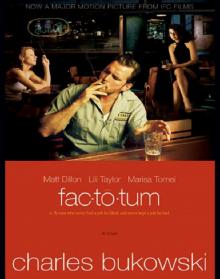 Factotum
Factotum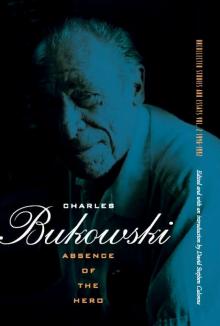 Absence of the Hero
Absence of the Hero Notes of a Dirty Old Man
Notes of a Dirty Old Man Mockingbird Wish Me Luck
Mockingbird Wish Me Luck Beerspit Night and Cursing
Beerspit Night and Cursing Ham on Rye: A Novel
Ham on Rye: A Novel Tales of Ordinary Madness
Tales of Ordinary Madness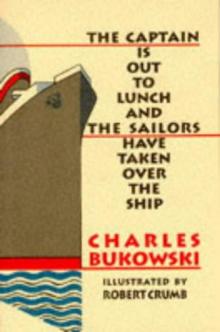 The Captain Is Out to Lunch and the Sailors Have Taken Over the Ship
The Captain Is Out to Lunch and the Sailors Have Taken Over the Ship The Pleasures of the Damned
The Pleasures of the Damned Come on In!
Come on In! Screams From the Balcony
Screams From the Balcony The Most Beautiful Woman in Town & Other Stories
The Most Beautiful Woman in Town & Other Stories New Poems Book 3
New Poems Book 3 Hot Water Music
Hot Water Music What Matters Most Is How Well You Walk Through the Fire
What Matters Most Is How Well You Walk Through the Fire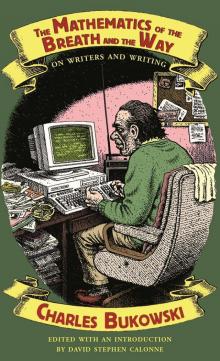 The Mathematics of the Breath and the Way
The Mathematics of the Breath and the Way The Roominghouse Madrigals: Early Selected Poems, 1946-1966
The Roominghouse Madrigals: Early Selected Poems, 1946-1966 Living on Luck
Living on Luck Pulp
Pulp You Get So Alone at Times That It Just Makes Sense
You Get So Alone at Times That It Just Makes Sense Post Office: A Novel
Post Office: A Novel The People Look Like Flowers at Last: New Poems
The People Look Like Flowers at Last: New Poems Hollywood
Hollywood Run With the Hunted: A Charles Bukowski Reader
Run With the Hunted: A Charles Bukowski Reader Storm for the Living and the Dead
Storm for the Living and the Dead South of No North
South of No North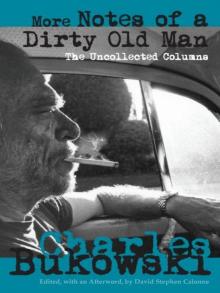 More Notes of a Dirty Old Man: The Uncollected Columns
More Notes of a Dirty Old Man: The Uncollected Columns On Drinking
On Drinking On Love
On Love The Days Run Away Like Wild Horses
The Days Run Away Like Wild Horses Play the Piano
Play the Piano Betting on the Muse
Betting on the Muse Women
Women The Most Beautiful Woman in Town
The Most Beautiful Woman in Town The Captain Is Out to Lunch
The Captain Is Out to Lunch Ham On Rye
Ham On Rye New Poems Book Three
New Poems Book Three The Roominghouse Madrigals
The Roominghouse Madrigals Post Office
Post Office The People Look Like Flowers At Last
The People Look Like Flowers At Last